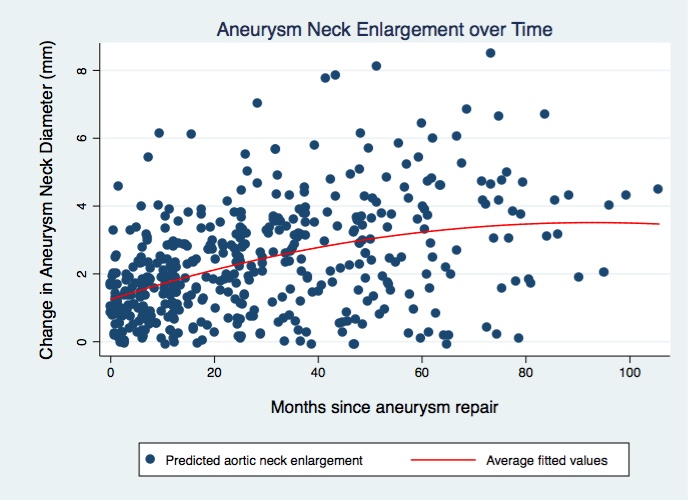Back to 2016 Annual Meeting Posters
Natural history of aneurysm neck size progression after endovascular repair of infrarenal abdominal aortic aneurysm
Tyler McElwee1, Joseph L. Mills1, Benoit Lapointe2, George T. Pisimisis1, Neal R Barshes1, Jayer Chung1, Panos Kougias1
1Baylor College of Medicine, Houston, TX;2Laval University, Quebec, QC, Canada
Introduction: Endovascular aneurysm repair (EVAR) represents the primary treatment modality for infrarenal abdominal aortic aneurysms. However, the effect of endograft placement on the size of the infrarenal aortic neck remains unclear. In this study we sought to evaluate variables that are associated aortic neck remodeling, and to create a model predictive of changes in aortic neck diameter after EVAR.
Methods: We conducted a retrospective cohort study of patients who underwent EVAR at a single institution. Aortic neck diameter was defined as the minor axis 1cm inferior to the lowest renal artery and was measured preoperatively and in follow up CT scans by two observers. EVAR stent-graft type and other patient characteristics were obtained from chart review. Multivariable linear regression was used to identify factors independently associated with long-term aortic neck diameter changes. Time was modeled using a piecewise restricted cubic spline function, to account for the possibility that the rate of aortic neck enlargement after EVAR changes over time.
Results: A total of 185 patients who underwent 647 CT scans over an 8 year period were included in the study. The median follow up was 38 months (interquartile range: 14 to 58 months). Time since endograft placement was a statistically significant predictor of neck enlargement: for the first four years after EVAR the aortic neck enlarged at an average rate of 1 mm/year (p < 0.001), whereas after the fourth year there was a slight increase in aortic neck size at average rate 0.6 mm/year (p=0.042). Length of the aortic neck (regression coefficient: -0.07, p < 0.001), and baseline aortic neck diameter (regression coefficient: -0.38, p < 0.001) were protective against increase in neck size; whereas history of chronic lung disease (regression coefficient: 1.4, p < 0.001) was associated with increase in neck size. Device type, the presence of active fixation at or above the renal arteries, and the presence of at least 50% circumference of neck calcification were not statistically significant predictors of the outcome. The predictive model incorporating the statistically significant covariates demonstrated that the aortic neck diameter enlarges for approximately 48 months, and then reaches a plateau averaging 3 mm increase compared to baseline. (Figure 1), although these findings should be interpreted with caution as the number of patients with follow up more than four years was limited.
Conclusion: The infrarenal aortic neck enlarges after EVAR. However, the increase in size is small, occurs mainly within the first four years after the procedure, and exhibits variability that reflect an effect of patient comorbidities and aortic neck characteristics. The clinical significance of this change remains to be determined.

Back to 2016 Annual Meeting Posters
